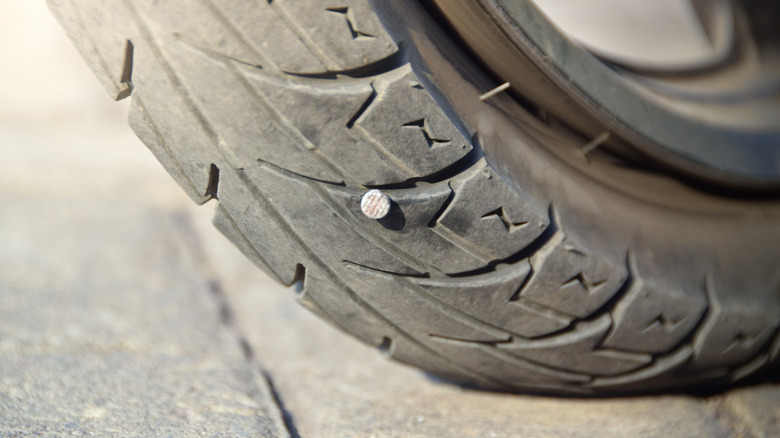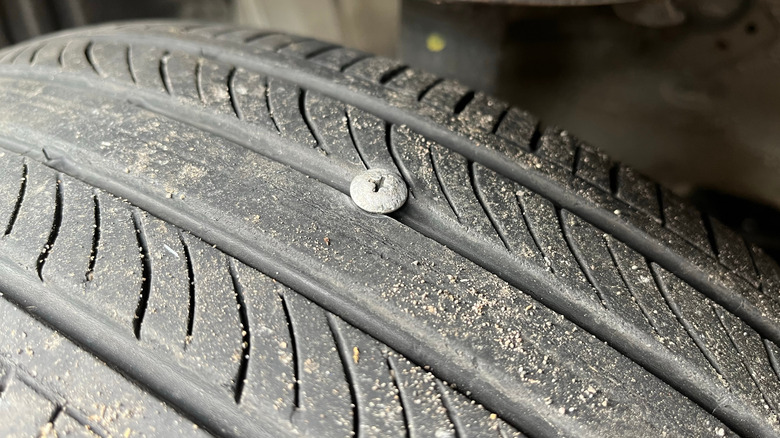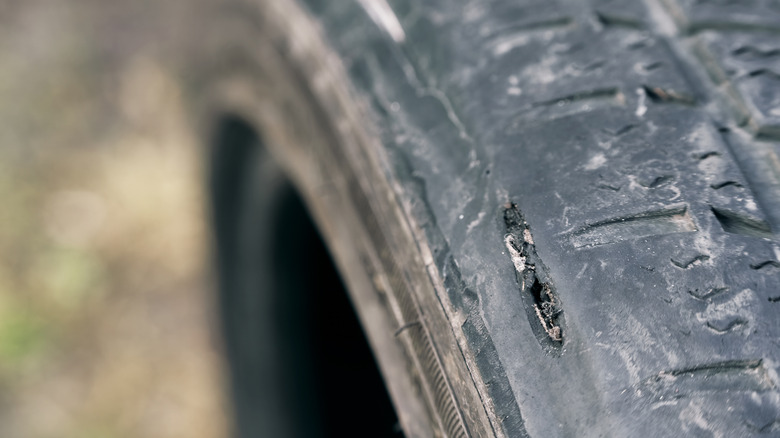How Close To The Sidewall Can You Patch A Tire?
One of the annoying things about being a car owner is that, no matter how good and careful of a driver you are, it's still completely possible for your car to get damaged. For example, even if you're making safe turns and following the speed limit on a road, if you run over a nail someone else left on the pavement, then you're the one who has to pay to get it fixed.
The good news about tire punctures is that you don't necessarily need to replace the whole tire. It is very possible to repair a hole in a tire, even on your own at home. It just needs to be filled with a special sealing cement and patched from within to prevent any further air leakage. It's not particularly expensive, even if you get it done at a garage. However, that ease comes with a very large asterisk — a tire can only be patched if it's damaged within a very particular radius. If a puncture occurs too close to the tire's sidewall, it won't be safe to put a patch on it, and if the sidewall itself is damaged, then the whole thing is a lost cause. The window for a safe patch is relatively large, but it becomes less safe to perform the closer you get to the sidewall, with the majority of repair professionals refusing to go any closer than a 1/2 inch away from it.
1/2 inch is generally considered the limit
The iron-clad rule for tire puncture patching is that a hole can only be filled if it occurs within the tire's tread area, i.e. the part of the tire that actually makes contact with the ground when it rolls. The actual size of the tread area will vary based on the make and model of the tire in question, but you can generally ballpark it by checking where the last tread line is on the tire. Past that last tread is where the metal surface of the interior sidewall begins, and that part can't be patched. Even if you tried, the flexion of the metal would gradually open it back up.
Unfortunately, a tire puncture can theoretically happen anywhere on the tire, even to the edge of the sidewall. If it's too close to that edge, a patch won't take, and repairing it won't be safe. The industry standard is that the puncture cannot be less than 1/2 inch from the sidewall. Admittedly, some tire manufacturers are willing to fudge that number a bit to as close as 1/4 inch from the sidewall. Even if the manufacturer says it's okay, though, if you have a repair professional telling you it isn't, you should listen to them.
On a related note, all of this repair talk is predicated on the assumption that the puncture in question is relatively small, less than 1/4 inch in diameter. This is why you can safely patch a hole from a nail, for instance. If the puncture is any larger than that, it cannot be patched, no matter where it is.
If the sidewall itself is damaged, the tire is a lost cause
It'd be bad enough if a puncture on the tread area were too close to the sidewall to be patched, but if the puncture happens on the sidewall itself, it's not even up for discussion. Any kind of puncture, gash, or even just a crack on the sidewall is grounds for scrapping the entire tire. Even if it looks small, or you're absolutely positive you could fix it, it doesn't matter.
There are two major problems with trying to patch the sidewall. Firstly, as we mentioned, the sidewall has a metal belt that's designed to flex and maintain the tire's shape. That flexing belt was not made with a patch in mind, and would tear any patch attempts right open with just a bit of driving. The other problem is a lack of viable patching area. If a puncture is in the tread area, the material is usually thick enough to safely house a patch. The sidewall's material is much thinner, too thin for a patch to properly apply to. It'd be like trying to repair torn scratch paper with duct tape.


